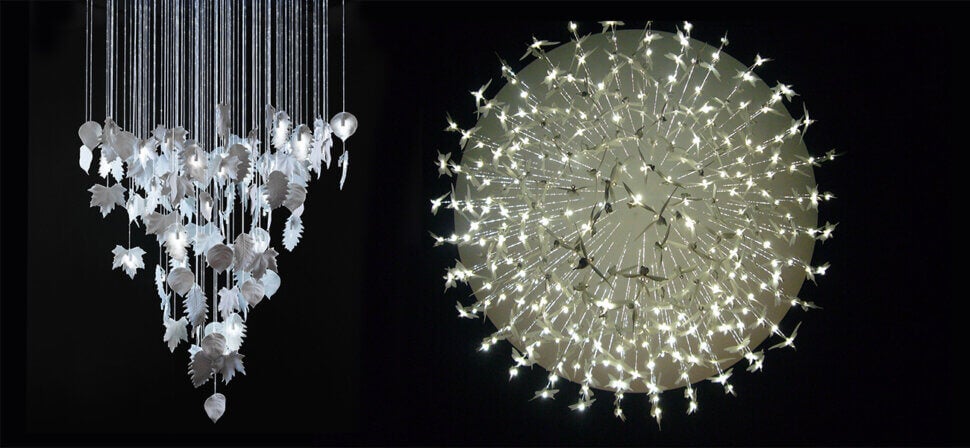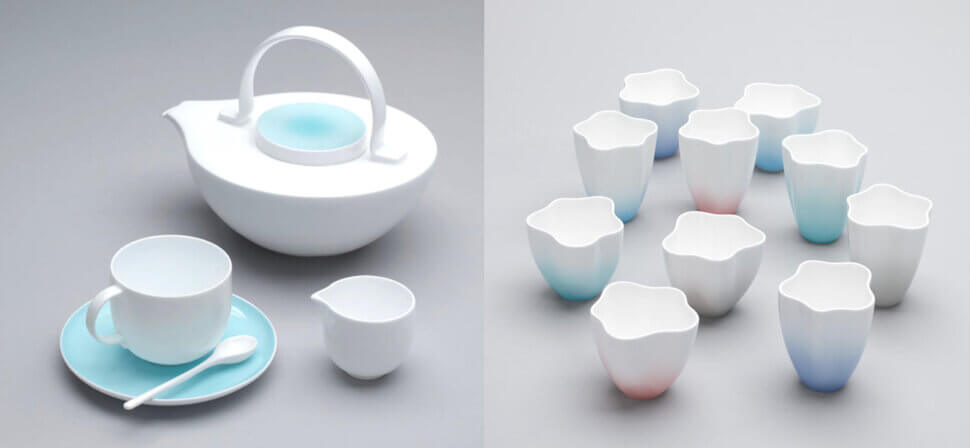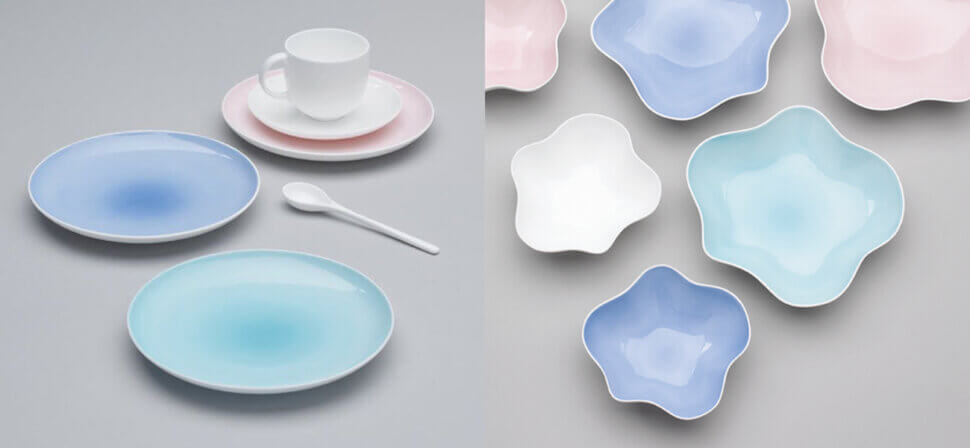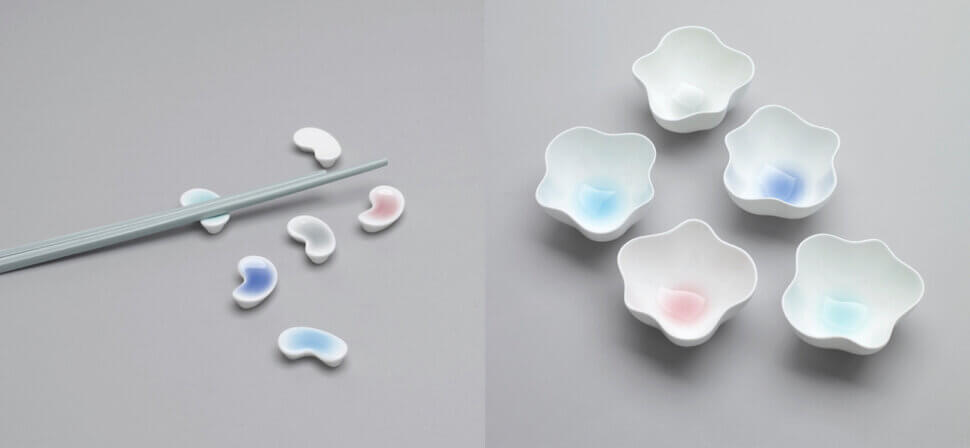Bodo Sperlien: Leading Light in the World of Product Design
June 7, 2019
Bodo Sperlein is a leading light in the world of product design, specialising in dinnerware, lighting and furniture. Miranda York spoke to him at his London showroom to find out more about the unique ceramics range used at Yauatcha.

TELL US A LITTLE BIT ABOUT YOUR BACKGROUND AND WHY YOU CHOSE TO FOCUS ON CERAMICS.
I studied 3D Design at Camberwell College of Arts and concentrated on ceramics very early on. I was fascinated with the materials but also felt there was a lack of good tableware on the market. The industry seemed to be lagging behind. It’s coming back now but I think table culture was lost for a while. The resurgence started with restaurants, with London becoming such a food hub, and I have to give chefs a lot of credit for changing the perception of food culture. They played a very important part in that. When you go to a restaurant you are also buying into an experience. It’s not just about good food, especially when you’re in the Michelin star category. Everything is taken into consideration: from the tableware to the lighting to the style of service.
I was keen to change the reputation of the industry. As a designer, I’m interested in changing something that is perceived quite negatively. It’s a challenge. If you start with something you love it’s much more difficult to improve upon. But if you choose something you don’t particularly like, it forces you to go deeper – Why don’t I like it? Why do I want to change it? How can I change it? It’s a better starting point for me.
YOU’VE DESIGNED TABLEWARE FOR MANY WELL-KNOWN RESTAURANTS AROUND THE WORLD. WHAT DRAWS YOU TO WORKING WITH RESTAURANTS AND CHEFS?
It sounds like a bit of a cliché but chefs are so creative; they push boundaries. They are incredibly knowledgeable and passionate about what they do and that gives you a lot of inspiration and food for thought. When chefs come to our showroom and talk about their food, they know in their head exactly what they want and how they see it working. And then of course we get to visit their restaurants for dinner, which is wonderful. You get to know how they work and you understand who they are. It’s a great honour that they come to us.

HOW DO YOU WORK WITH RESTAURANTS TO CREATE THEIR CERAMICS?
We have a wide portfolio of tableware and we work with several companies in Japan, Germany, as well as our own little manufacturer in Stoke-on-Trent. If people want something specific we can do that too. It seems to be more important now that tableware is unique, that it’s not the same as every other restaurant. Chefs and restaurateurs can be quite particular, which I thing is a good thing. No more hideous trends! They want to be unique without going too far. I love the campaign “We Want Plates”. There are some ridiculous products that have been misused for food consumption. I don’t get it. There are certain materials that work with food. There’s a reason why for thousands of years we’ve used the same materials.
HOW WOULD YOU DESCRIBE YOUR STYLE?
I like to use traditional materials so as to show a new generation that you can do amazing things with them. There’s a perception, for example, that bone china is very chintzy, and yet we’ve created very modern ranges with it. I made a decision early on in my studies that as a designer there’s a certain responsibility to make sure certain materials survive into the 21st century, to give them a new lease of life through beautiful or more contemporary design. So I guess I’d describe my style as contemporary classic. I don’t try to be too fashionable because fashionable easily becomes unfashionable. I’d rather leave a legacy behind.
For me, it’s a combination of the design, the material and the skill of the maker. I really focus on the makers and the enormous amount of skill it takes to make, for example, a beautiful bone china cup. It’s important to remember how long it takes to produce something like that. There’s a lot of skill and a lot of training behind a seemingly simple item. I want to be quite educational without becoming a librarian. I want my products to tell a story.
HOW DID YOU COME TO WORK WITH YAUATCHA ON THEIR TABLEWARE?
I started working with a Japanese company called Nikko, a fine ceramics manufacturer founded in 1908 in Kanazawa, on a range called Blossom. When Yauatcha saw the range they felt it encapsulated everything they were about. They wanted to differentiate themselves from the rest of the market and they saw something in the tableware that was archetypical Yauatcha. It looks beautiful. It’s important in a restaurant that the food looks good on the plate but it also needs to be functional. It needs to be stackable and easy to serve and clear away. The Blossom – as well as the Macaroon collection with its graduated pigments – fitted in so well they became the key range.

WHAT WAS THE INSPIRATION BEHIND THE RANGE?
I called it Blossom because of the biomorphic shapes. The delicate colours and organic shapes mean it has a certain fluidity. I wanted to showcase through the shape what the material can do, and working with the Japanese, who have far more skill than a lot of the European manufacturers that are semi-automatic, meant that we could create the complicated shapes and overcome the challenges. The quality is second to none – from the colour application to the finish of the clay. I chose the colours because they felt natural, soft and calm. I didn’t want a solid, flat colour, so we created a graduation – an intense centre that fades out towards the edges of the white china rim. When it comes to unusual colour choices such as pink and grey, it’s about choosing the right shade. There was a lot of toning down, playing around with pigment, and experimenting to get the right shade.

HOW DOES IT FEEL TO SEE YOUR CREATIONS BEING USED IN THE RESTAURANT?
I’m always intrigued how people use the products we make. We never dictate how the products should be used. I’d rather let people choose for themselves. I start with the shape and don’t think too much about what will be placed within it, unless perhaps it’s something very specific like a rice bowl. Eating in restaurants and discovering how everything is being used is fascinating.
HAS CHINESE FOOD CULTURE INFLUENCED YOU IN ANY WAY?
As a child I was quite obsessed with China and Chinese culture. I’ve also visited the country several times – a lot of the tiny, ancient lake towns, as well as Shanghai. China is the birthplace of porcelain so it’s very important to the history of ceramics. I’m especially interested in the celadon plates – that was the starting point for the Nikko project – the beautiful celadon shades of grey, blue, jade green. It’s also interesting to see people bringing Chinese food into the 21st century. Often what you find in Chinatown isn’t what you find in China – there are so many variations and styles of cooking. I’m personally a fan of the Hong Kong style of food which they serve in Yauatcha. I love the concept of dim sum too – sharing stacks and stacks of bamboo baskets at any time of the day.

WHAT ARE YOUR THOUGHTS ON THE RITUAL OF DIM SUM – AND THE RITUAL OF SITTING DOWN TO EAT IN GENERAL?
The plates and tableware I design serve as a platform for the food. Placing the food on the plate is a form of ritual. You’re not just plonking it on a plate, there’s thought and consideration that goes into it. Perhaps it’s something that you predominantly experience in a restaurant, but it’s something that can be recreated at home too. Table culture is changing at the moment – people are thinking more deeply about it again. It’s almost an antidote to our hectic lifestyles; a chance to slow down and enjoy good food and company.
I also think dinner parties are important – and fun! It’s good to sit down with friends you haven’t seen for a while. And of course if you invite people to dinner parties, they have to invite you back.
WHAT DOES YOUR DINNER TABLE LOOK LIKE?
I mix and match a lot, especially when it comes to ceramics and linens. I really like silver at the moment too – it elevates the table without being too formal. I wouldn’t go so far as to iron the tablecloth but a nicely laid out table is something quite amazing to behold.
WHAT’S EXCITING YOU IN DESIGN RIGHT NOW?
The current appreciation of craft and skill. More and more people are starting to question where things come from and how they are made. It started with food – with farmer’s markets and the slow food movement for example – and it’s expanded to what you might call slow manufacturing. There’s also a whole discussion around what luxury means today. It’s not about expensive designer brands, it’s about having the time to discover something and searching for the unique.
I don’t want to be a designer that just pushes a button on a 3D printer. What I find interesting is how you can combine high tech and low tech – using machines and handmade elements, pushing the boundaries and elevating design. We need to look at so-called old fashioned materials and give them a new lease of life so as help them survive. We’re in danger of losing hundreds of thousands of years of skills if we don’t. Luckily a new generation is interested in this heritage, in products that tell a story. I’m glad that’s become important to people again.
